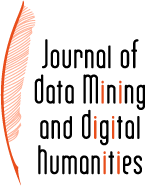 |
Christian Hessle ; John Kirk - Digitising Collections of Historical Linguistic Data: The Example of The Linguistic Atlas of Scotland
jdmdh:5611 - Journal of Data Mining & Digital Humanities, 22 décembre 2020, Numéro spécial sur les visualisations en linguistique historique - https://doi.org/10.46298/jdmdh.5611
This article addresses the issue of variation in the lexicon-specifically the hyponymy (or synonymy) among onomasiological responses for the same concept or referent-and how the range of responses from a national elicitation in Scotland seeking 'local' words should be judged. How do responses being offered as 'local' square with their geographical distribution on the one hand, and their status as 'Scots' or 'English', or as 'dialect' or 'standard' on the other? How are 'dialect' or 'standard' responses offered as 'local' responses from the same individual to be considered? Is the issue that of a straightforward dialect-standard binary opposition, or is there a third value between the two? Does that third value encompass a middle ground between dialect and standard, or include both? How is the absence of responses to be regarded? For elucidation of such linguistic issues, the article invokes the mathematical principle of the excluded middle. This study shows that it is possible and necessary to establish a theoretical framework for the digitalisation of a historical data collection. The data for these reflections come from the lexical material in The Linguistic Atlas of Scotland ([Mather and Speitel, 1975]; [1977]), which is currently being digitised at the University of Vienna. This study presents three pilot studies from the North Mid Scots area: the atlas concepts of 'ankle', 'splinter' and 'the youngest of a brood or litter'. The original data are re-analysed in terms of lexical types or 'lexemes', and the results are digitally generated by new dot maps, with separate gestations for respondent age and gender. In the process, topological issues (such as those pertaining to the data) and topographical issues (such as those pertaining to geography and the physical terrain) are addressed.